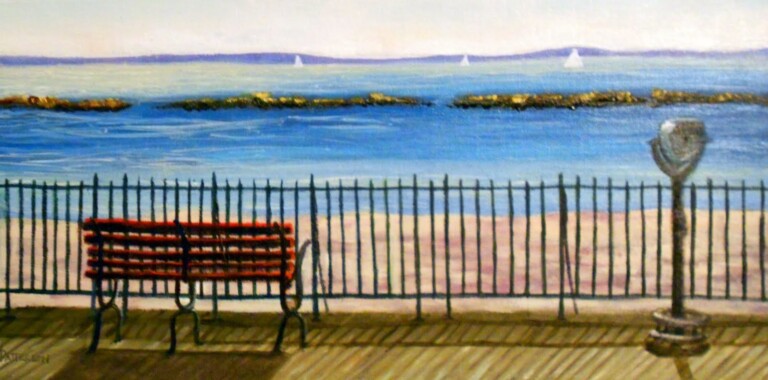Holding Court: Does Law Imitate Art?

Holding Court is a series by retired Rye City Court Judge Joe Latwin. Latwin retired from the court in December 2022 after thirteen years of service to the City.
What topics do you want addressed by Judge Latwin? Tell us.
By Joe Latwin
If you’ve seen several recent movies, you’re going to find a recent New York case familiar. Cabaret, Schindler’s List, the Monuments Men, Band of Brothers, The Hunt for the Amber Room, and The Woman in Gold are among the movies imitated. The case was in the Matter of the Art Institute of Chicago. The New York County District Attorney’s Office Antiquities Trafficking Unit’s requested a turnover order for an artwork by Austrian artist Egon Schiele titled Russian War Prisoner, that was in the physical possession of the Art Institute of Chicago. The application requested that the artwork be returned to the possession of the co-executors of the estates of the legally-declared heirs of Fritz Grünbaum, who owned the painting before his murder by the Nazis at Dachau Concentration Camp during the Holocaust.
Fritz Grünbaum was a performer and art collector. He was the Master of Ceremonies at the famed Kabarett Simpl in Austria. He inspired the Joel Grey character in the play and movie Cabaret. Grünbaum was the son of an art dealer, and a collector of art including hundreds of paintings, drawings, etchings, and engravings by contemporary Austrian avant-garde artists including Egon Schiele, a mentee of Gustav Klimt. Among the dozens of Schiele pieces in Grünbaum’s collection was the 1916 Russian War Prisoner.
Following Adolf Hitler’s rise to power in 1933 and the Anschluss in Austria in 1938, Jewish performers, including Grünbaum were banned from performing. Grünbaum was quickly arrested, detained and transferred to Dachau Concentration Camp on May 24, 1938. Hitler also believed that most modern art, especially the Expressionist art practiced by Schiele, was reflective of society’s moral decline and a result of the genetic inferiority of the artists. The Nazi Party thus identified these works of art as “degenerate” and ordered that they be removed from museums and banned in Nazi-occupied territories. To further these efforts, the Nazi Party established the Reich Culture Chamber to identify and confiscate artwork that they considered to be “degenerate” in nature. A select few art dealers were tasked by the Reich Chamber for Culture with selling “degenerate” artworks, including the works of Egon Schiele. The proceeds were often appropriated by the dealers or used to fund the Nazi war efforts.
The Nazis began a systematic confiscation and seizure of Jewish property by the Regulation on the Declaration of Assets of Jews that required “every Jew” to register any property or assets that were valued at more than 5,000 Reichsmarks. Once the property was registered, it was placed in a storage facility which was, for all intents and purposes, under the complete control of the Nazi Party. To add insult to injury, Jews were required to finance the storage of their belongings in these facilities. When a “customer” failed to pay these storage facilities, or when citizenship was rescinded, or when the owners died or were murdered without heirs, the warehouseman was authorized to sell the property, either privately or at public auction.
Grünbaum’s wife attempted to comply with the regulations by filing her Declaration of Assets but could not have Grünbaum, the owner, sign since he was in Dachau. Grünbaum’s in-laws sought an export permit to get the paintings including the Russian War Prisoner, to Belgium, but there was no record it was ever shipped to Belgium.
Dayenu. The Nazi government enacted the Order Concerning the Utilization of Jewish Property, which extinguished the property rights of Jews.
Grünbaum would suffer three years of detainment at multiple concentration camps before succumbing to tuberculosis in 1941. His wife was arrested and deported to an Extermination Camp in what is now Belarus. She was almost certainly murdered by firing squad shortly after her arrival, as was standard practice at the camp. In June 1944, the camp was burned to the ground in anticipation of the arrival of the Soviet army, with all surviving prisoners still inside. The Grünbaums had no children. The in-laws died in the 1970s.
Following the end of the war, an art dealer, Gurlitt’s collection was confiscated by the Allied authorities. Gurlitt argued that he himself had been a victim of the Nazi’s policies due to his own Jewish heritage. Gurlitt then successfully petitioned to have one hundred and fifteen pieces of art returned to him. Gurlitt died and bequeathed his art collection to his wife and children, including his only son, Cornelius. In 2012, Cornelius’ home was raided by German authorities who recovered more than one thousand five hundred works of art that had been looted by his father during World War II. Following Cornelius’ s death in 2014, what remained of Gurlitt’s art collection was bequeathed to the Museum of Fine Arts in Bern. Another repository for looted art became Galerie Kornfeld, a privately-owned Swiss auction house where Cornelius was a regular client. Several pieces of art were sold in a series of sales between 1955 and 1956, leading to the transport of several of the works, Russian War Prisoner included, to New York City. Twenty of the 63 Schiele artworks that found their way to Galerie Kornfeld were purchased in 1956 for Gallerie St. Etienne in Manhattan. Russian War Prisoner was purchased by Connecticut-based art dealer David Kimball. Kimball then sold the artwork to Louisiana gallery owner, who in turn sold Russian War Prisoner to B.C. Holland in Chicago. Holland sold Russian War Prisoner to the Art Institute of Chicago, where it has remained since. The Art Institute of Chicago had an intern connect Galerie Kornfeld to the ownership history of Russian War Prisoner. Kornfeld responded stating that the artwork originated from Grünbaum’s collection, which he purchased from the sister-in-law. Kornfeld claimed that Grünbaum’s collection was never seized by Nazi authorities and that instead the sister-in-law kept the collection until she sold several pieces.
The Court began with assessing the scope of the problem.
Determining true ownership of Nazi-looted art is a demonstrably complex process, due largely in part to the passage of time, the fact that the thefts occurred during times of war, the multiple transfers of ownership following their seizure, and the unavailability of records documenting their movement over time.
“[T]he displacement of art during World War II was unprecedented. Never before had there been such a massive amount of artwork removed from so many countries during wartime: millions of artistic objects of every description were systematically confiscated. The seizing of art work from Jewish collections all over Europe and Asia was part of a process of persecution, dehumanization and eventual annihilation.” Throughout the course of World War II, the Nazis looted an estimated 150,000 pieces of art from Western Europe and another 500,000 artworks from countries within Eastern Europe, equating to “approximately one-fifth of all Western European art then in existence.” After only twelve years in power, the Nazi Party either displaced, stole, or transported as much art as was misappropriated during the entire Thirty Years War or all the Napoleonic Wars.] In total, the Nazis plundered an estimated $2.5 billion (today’s value: $20.5 billion) worth of artworks which were then either sold to finance the war effort, or further plundered by Nazi officials.
In order to determine who is entitled to ownership of Russian War Prisoner, the Court had to make several findings. First, the Court had to determine whether Russian War Prisoner constituted “stolen property”. Next, the Court had to whether it had jurisdiction over the artwork. The Court must next determine whether the application was time-barred. If the application is not time-barred, the Court needed to evaluate whether Criminal Procedure Law § 450.10, which provides for the return of stolen property to its owners, is the appropriate mechanism for the relief requested in this case.
The Court found that, prior to World War II, Grünbaum was the lawful owner of Russian War Prisoner. Therefore, Russian War Prisoner was considered “stolen” when it was placed in the Nazi-controlled storage facility, when the inventory was compiled for the express purpose of moving the belongings to the Nazi-controlled storage facility, and when the Nazis appointed a trustee to oversee Grünbaum’s belongings. Finding that the property was Grünbaum’s before it was stolen, it said under New York law, a thief cannot pass good title. The Court found that New York case law has long protected the right of the owner whose property has been stolen to recover that property, even if it’s in the possession of a good-faith purchaser for value.
After finding that New York had jurisdiction and the claims were not time barred, the Court found the mechanism employed was proper to compel return of the property. The Court ordered that Russian War Prisoner relinquished to the legal heirs of its last legitimate owner, Fritz Grünbaum.
Roll the credits.






